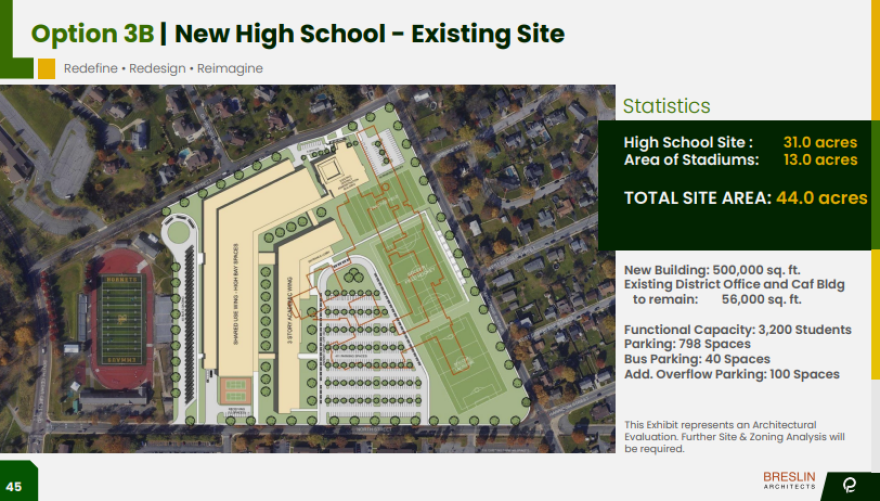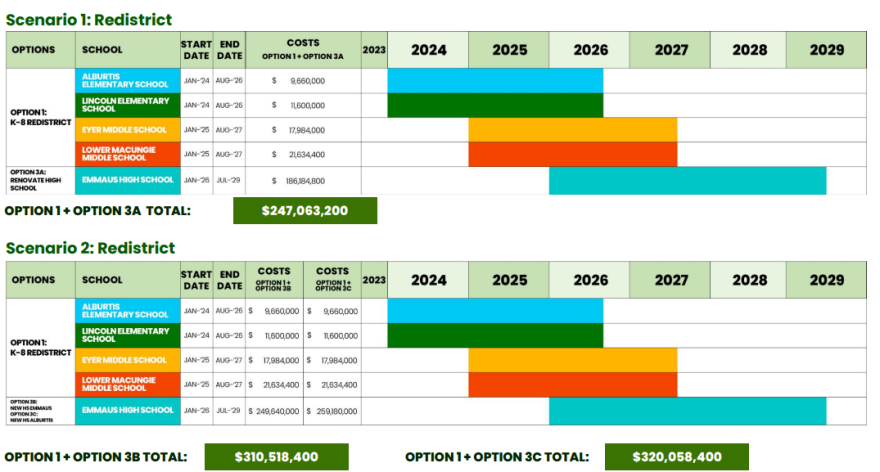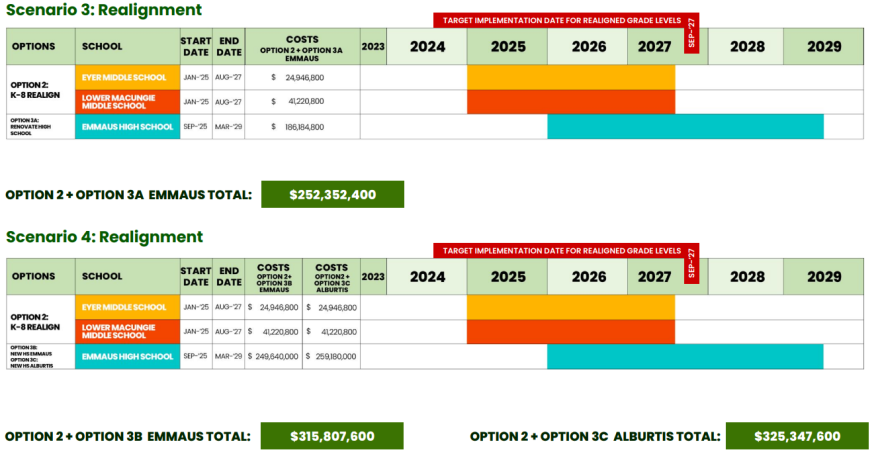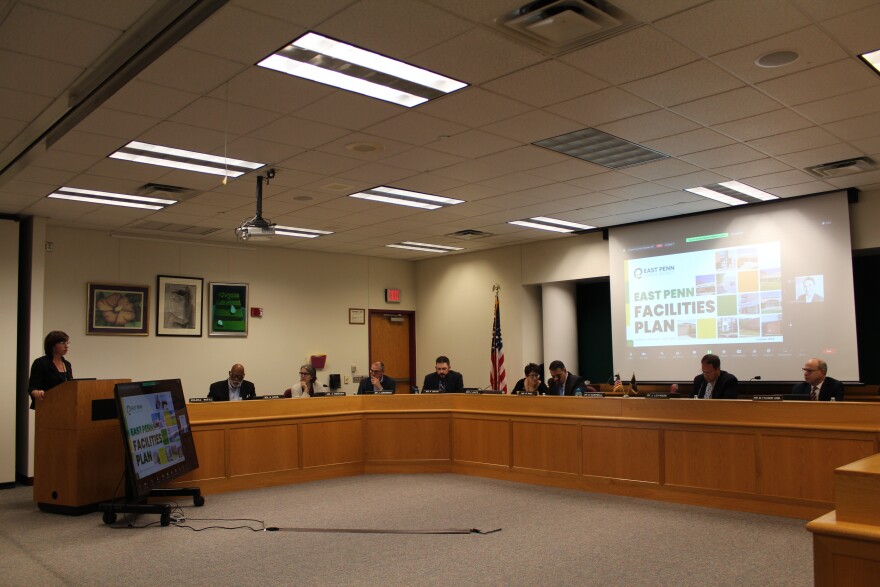- The East Penn School Board held a presentation about proposed facilities expansions
- Tax increases are anticipated, but the district says it's a need due to anticipated enrollment increases
- Options included shifting grades 5/6 and 7/8 into their own buildings, and building a new high school
EMMAUS, Pa. — As East Penn School District's population continues to grow alongside its increasingly densifying municipalities of Lower Macungie Township, Emmaus and all of Lehigh County, the schools are looking to grow to meet that increase.
In a process dating to a 2021 facility study, East Penn administration and consultant partners on Monday gave a nearly four-hour presentation to the school board on how it could meet the growth — and how strains already are felt.
Projections by the administration and its partners show enrollment size growing from 8,005 in 2022 to 8,486 in 2032.
"A critical piece for us all to latch onto is that there are capacity needs at several buildings that must be addressed in the short term. And I'm defining short term is like five-year period of time."East Penn Schools Superintendent Kristen Campbell
To accommodate that, the district is looking to spend hundreds of millions of dollars on expansions and changes to its elementary, middle and high schools.
The question presented, however, is what changes the district will choose make to its schools.
"A critical piece for us all to latch onto is that there are capacity needs at several buildings that must be addressed in the short term," Superintendent Kristen Campbell said during the presentation.
"And I'm defining short term is like five-year period of time."
The presentation said the district wants to address overcrowding and create modern learning spaces, with the understanding that the current existing schools are in good condition.
The presentation detailed how the administration engaged with the community via listening sessions and surveying in the process of developing the plan.
Priorities from those showed academics, class size and equitable access to programming and resources were community priorities.
Expansion plans also were introduced earlier this year for Parkland High School, which faces similar population pressures.
Significant changes on the table for K-8
A major crux of the presentation focused on restructuring how the district handles its middle schools.
A pushed-for option is to realign the district's grades to move all fifth- and sixth-graders to Eyer Middle School and all seventh- and eighth-graders to Lower Macungie Middle School, with additions and changes to each building to accommodate the change.
Administrators said realigning the grades would create benefits by getting those grades together much earlier, and leading to more opportunities for instructor collaboration among each grade's teachers.
"We see potential benefit in having all of our students come together to begin to build that sense of culture and community as early as possible," Campbell said.
Concerns include introducing another significant facility transition for the students, a worry specifically centered around autistic support and special education.
Students in the seventh-eighth-grade building would be separated into two "teams" based on elementary school boundaries for arts and some athletics, while transportation would be separate for grades five-six and seven-eight.
EPSD Facilities Plan by LehighValley Newsdotcom on Scribd
The alternative would be to keep the current K-5 and 6-8 configuration, which would require adding seven classrooms each to the Alburtis and Lincoln elementary buildings and at least one of the middle schools.
The second option also would involve realigning the middle school boundaries, no longer making Lower Macungie Middle School non-contiguous and create a more even number of students that would get free lunch benefits.
Proposed realignment of current elementary and middle school boundaries would affect about 340 K-4 elementary students and about 2,515 students in grades 5-8.
Three visions for high school changes
Big changes are planned for the high school, where the whole population of each grade now meets under the same roof.
Options presented are to add to the existing high school, build a new high school on the same plot of land or build a new high school on a separate property the district owns.
The existing building is 448,800 square feet and accommodates 2,770 students.

The option of renovations and adding to the building proposes 184,000 square feet, increasing the capacity by 430 to 3,200.
In addition to new classrooms, it also would add a new gymnasium and auditorium and turn the current gymnasium into a music suite. It would cost an estimated $186,184,800.
The second option, to build a new high school on the existing site, would bring the estimated capacity to 3,200 students.
The new three-story building would largely go on top of existing athletics fields, with the cafeteria and administrative building set to stay. It would cost an estimated $249,640,000.
A third option would move the high school out of Emmaus entirely to a site off of the Sauerkraut Lane Extension project near Alburtis to construct a new 500,000-square-foot, 3,000-capacity building.
Construction would cost an estimated $259,180,000.
District officials noted they do not have an estimate of what the value of the current high school's site would be in the case of a move to a new location.
Development to complete by 2029
Options proposed are set to be completed by the end of the decade, with a board decision on redistricting or realignment for K-8 needs now proposed for the Nov. 13 meeting.
The proposed "next steps" timeline also proposes approval for a Request for Proposal for engineering services, design of building projects and program design for this winter.
A board decision on funding for facilities projects related to high school priorities, design and planning is proposed for spring.
Board members Jennifer Bowen and Joshua Levinson spoke to a need for the decision to be made on this accelerated timeline.
With an election coming up shortly, they emphasized that the current board, which has seen and been involved in the facilities expansion process, soon will be shaken up.
"I think we're getting very close to a point where the makeup of this board is going to change — potentially dramatically," Bowen said.
"I understand that it feels like a lot of pressure to make a decision in two weeks, but I think it might almost be less wise to push the decision and end up with a brand-new board or slightly new composition board when some of us who may be vacating our seats have at least been around for last year's presentation and some of these last several weeks of discussion."


Financing for the project would involve tax increases over the next decade to at least an additional 1.943 mills.
A million dollars of new annual transportation costs would be involved in 2027-28.
"This is a need situation," board member Allan Byrd said. "The longer we wait, that needs is going to get bigger. But give them time to work on it and move forward and make that decision, so let's park here. This is a start."
Estimated costs involving each option would include $247,063,200 for high school renovations and redistricting, $320,058,400 for a new high school and redistricting, $252,352,400 for renovating the high school and realigning grades, and $325,347,600 for a new high school and realigning grades.
Staffing additions would come alongside the expansions, such as teachers, with proposals to keep some currently ESSER-funded positions.
Board member Alisa Bowman requested an itemization of proposed employment changes that would go alongside the proposals.


